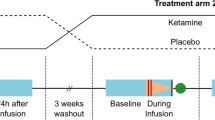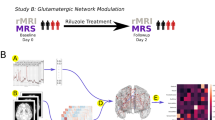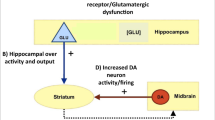Abstract
A growing body of evidence suggests glutamate excess in schizophrenia and that N-methyl-d-aspartate receptor (NMDAR) hypofunction on γ-aminobutyric acid (GABA) interneurons disinhibiting pyramidal cells may be relevant to this hyperglutamatergic state. To better understand how NMDAR hypofunction affects the brain, we used magnetic resonance spectroscopy and resting-state functional magnetic resonance imaging (MRI) to study the effects of ketamine on hippocampal neurometabolite levels and functional connectivity in 15 healthy human subjects. We observed a ketamine-induced increase in hippocampal Glx (glutamate+glutamine; F=3.76; P=0.04), a decrease in fronto-temporal (t=4.92, PFDR<0.05, kE=2198, x=−30, y=52, z=14) and temporo-parietal functional connectivity (t=5.07, PFDR<0.05, kE=6094, x=−28, y=−36, z=−2), and a possible link between connectivity changes and elevated Glx. Our data empirically support that hippocampal glutamatergic elevation and resting-state network alterations may arise from NMDAR hypofunction and establish a proof of principle whereby experimental modelling of a disorder can help mechanistically integrate distinct neuroimaging abnormalities in schizophrenia.
This is a preview of subscription content, access via your institution
Access options
Subscribe to this journal
Receive 12 print issues and online access
$259.00 per year
only $21.58 per issue
Buy this article
- Purchase on Springer Link
- Instant access to full article PDF
Prices may be subject to local taxes which are calculated during checkout



Similar content being viewed by others
References
Kraguljac NV, White DM, Reid MA, Lahti AC . Increased hippocampal glutamate and volumetric deficits in unmedicated patients with schizophrenia. JAMA Psychiatry 2013; 70: 1294–1302.
de la Fuente-Sandoval C, Leon-Ortiz P, Favila R, Stephano S, Mamo D, Ramirez-Bermudez J et al. Higher levels of glutamate in the associative-striatum of subjects with prodromal symptoms of schizophrenia and patients with first-episode psychosis. Neuropsychopharmacology 2011; 36: 1781–1791.
Kegeles LS, Mao X, Stanford AD, Girgis R, Ojeil N, Xu X et al. Elevated prefrontal cortex gamma-aminobutyric acid and glutamate-glutamine levels in schizophrenia measured in vivo with proton magnetic resonance spectroscopy. Arch Gen Psychiatry 2012; 69: 449–459.
Moghaddam B, Javitt D . From revolution to evolution: the glutamate hypothesis of schizophrenia and its implication for treatment. Neuropsychopharmacology 2012; 37: 4–15.
Olney JW, Farber NB . Glutamate receptor dysfunction and schizophrenia. Arch Gen Psychiatry 1995; 52: 998–1007.
Javitt DC . Twenty-five years of glutamate in schizophrenia: are we there yet? Schizophr Bull 2012; 38: 911–913.
Heckers S, Konradi C . GABAergic mechanisms of hippocampal hyperactivity in schizophrenia. Schizophr Res 2014; 167: 4–11.
Kraguljac NV, Reid M, White D, Jones R, den Hollander J, Lowman D et al. Neurometabolites in schizophrenia and bipolar disorder - a systematic review and meta-analysis. Psychiatry Res 2012; 203: 111–125.
Benes FM, Khan Y, Vincent SL, Wickramasinghe R . Differences in the subregional and cellular distribution of GABAA receptor binding in the hippocampal formation of schizophrenic brain. Synapse 1996; 22: 338–349.
Hutcheson NL, Reid MA, White DM, Kraguljac NV, Avsar KB, Bolding MS et al. Multimodal analysis of the hippocampus in schizophrenia using proton magnetic resonance spectroscopy and functional magnetic resonance imaging. Schizophr Res 2012; 140: 136–142.
Lahti AC, Weiler MA, Holcomb HH, Tamminga CA, Carpenter WT, McMahon R . Correlations between rCBF and symptoms in two independent cohorts of drug-free patients with schizophrenia. Neuropsychopharmacology 2006; 31: 221–230.
Biswal B, Yetkin FZ, Haughton VM, Hyde JS . Functional connectivity in the motor cortex of resting human brain using echo-planar MRI. Magn Reson Med 1995; 34: 537–541.
Samudra N, Ivleva EI, Hubbard NA, Rypma B, Sweeney JA, Clementz BA et al. Alterations in hippocampal connectivity across the psychosis dimension. Psychiatry Res 2015; 233: 148–157.
Knochel C, Stablein M, Storchak H, Reinke B, Jurcoane A, Prvulovic D et al. Multimodal assessments of the hippocampal formation in schizophrenia and bipolar disorder: evidences from neurobehavioral measures and functional and structural MRI. Neuroimage Clin 2014; 6: 134–144.
Kraguljac NV, White DM, Hadley N, Hadley JA, Ver Hoef L, Davis E et al. Aberrant hippocampal circuitry in unmedicated patients with schizophrenia and effects of antipsychotic medication: a longitudinal resting state functional MRI study. Schizophr Bull 2016; 42: 1046–1055.
Kraguljac NV, White DM, Hadley J, Reid MA, Lahti AC . Hippocampal-parietal dysconnectivity and glutamate abnormalities in unmedicated patients with schizophrenia. Hippocampus 2014; 24: 1524–1532.
Zhou Y, Shu N, Liu Y, Song M, Hao Y, Liu H et al. Altered resting-state functional connectivity and anatomical connectivity of hippocampus in schizophrenia. Schizophr Res 2008; 100: 120–132.
Duan HF, Gan JL, Yang JM, Cheng ZX, Gao CY, Shi ZJ et al. A longitudinal study on intrinsic connectivity of hippocampus associated with positive symptom in first-episode schizophrenia. Behav Brain Res 2015; 283: 78–86.
Sapkota K, Mao Z, Synowicki P, Lieber D, Liu M, Ikezu T et al. GluN2D N-Methyl-d-aspartate receptor subunit contribution to the stimulation of brain activity and gamma oscillations by ketamine: implications for schizophrenia. J Pharmacol Exp Ther 2016; 356: 702–711.
Yamamoto T, Nakayama T, Yamaguchi J, Matsuzawa M, Mishina M, Ikeda K et al. Role of the NMDA receptor GluN2D subunit in the expression of ketamine-induced behavioral sensitization and region-specific activation of neuronal nitric oxide synthase. Neurosci Lett 2016; 610: 48–53.
von Engelhardt J, Bocklisch C, Tonges L, Herb A, Mishina M, Monyer H . GluN2D-containing NMDA receptors-mediate synaptic currents in hippocampal interneurons and pyramidal cells in juvenile mice. Front Cell Neurosci 2015; 9: 95.
Lahti AC, Koffel B, LaPorte D, Tamminga CA . Subanesthetic doses of ketamine stimulate psychosis in schizophrenia. Neuropsychopharmacology 1995; 13: 9–19.
Lahti AC, Weiler MA, Tamara Michaelidis BA, Parwani A, Tamminga CA . Effects of ketamine in normal and schizophrenic volunteers. Neuropsychopharmacology 2001; 25: 455–467.
Lahti AC, Holcomb HH . Schizophrenia, VIII: pharmacologic models. Am J Psychiatry 2003; 160: 2091.
Parwani A, Weiler MA, Blaxton TA, Warfel D, Hardin M, Frey K et al. The effects of a subanesthetic dose of ketamine on verbal memory in normal volunteers. Psychopharmacology (Berl) 2005; 183: 265–274.
Weiler MA, Thaker GK, Lahti AC, Tamminga CA . Ketamine effects on eye movements. Neuropsychopharmacology 2000; 23: 645–653.
Lahti AC, Warfel D, Michaelidis T, Weiler MA, Frey K, Tamminga CA . Long-term outcome of patients who receive ketamine during research. Biol Psychiatry 2001; 49: 869–875.
Kraguljac NV, Reid MA, White DM, den Hollander J, Lahti AC . Regional decoupling of N-acetyl-aspartate and glutamate in schizophrenia. Neuropsychopharmacology 2012; 37: 2635–2642.
Hutcheson NL, Sreenivasan KR, Deshpande G, Reid MA, Hadley J, White DM et al. Effective connectivity during episodic memory retrieval in schizophrenia participants before and after antipsychotic medication. Hum Brain Mapp 2015; 36: 1442–1457.
Hamilton M . Rating depressive patients. J Clin Psychiatry 1980; 41: 21–24.
Young RC, Biggs JT, Ziegler VE, Meyer DA . A rating scale for mania: reliability, validity and sensitivity. Br J Psychiatry 1978; 133: 429–435.
Bremner JD, Krystal JH, Putnam FW, Southwick SM, Marmar C, Charney DS et al. Measurement of dissociative states with the Clinician-Administered Dissociative States Scale (CADSS). J Trauma Stress 1998; 11: 125–136.
Overall J, Gorham D . The brief psychiatric rating scale. Psychol Rep 1962; 10: 799–812.
Schubert F, Gallinat J, Seifert F, Rinneberg H . Glutamate concentrations in human brain using single voxel proton magnetic resonance spectroscopy at 3 Tesla. Neuroimage 2004; 21: 1762–1771.
Vanhamme L, van den Boogaart A, Van Huffel S . Improved method for accurate and efficient quantification of MRS data with use of prior knowledge. J Magn Reson 1997; 129: 35–43.
Whitfield-Gabrieli S, Nieto-Castanon A . Conn: a functional connectivity toolbox for correlated and anticorrelated brain networks. Brain Connect 2012; 2: 125–141.
Behzadi Y, Restom K, Liau J, Liu TT . A component based noise correction method (CompCor) for BOLD and perfusion based fMRI. Neuroimage 2007; 37: 90–101.
Power JD, Barnes KA, Snyder AZ, Schlaggar BL, Petersen SE . Steps toward optimizing motion artifact removal in functional connectivity MRI; a reply to Carp. Neuroimage 2012; 76: 439–441.
Caprihan A, Jones T, Chen H, Lemke N, Abbott C, Qualls C et al. The paradoxical relationship between white matter, psychopathology and cognition in schizophrenia: a diffusion tensor and proton spectroscopic imaging study. Neuropsychopharmacology 2015; 40: 2248–2257.
Fornito A, Harrison BJ, Goodby E, Dean A, Ooi C, Nathan PJ et al. Functional dysconnectivity of corticostriatal circuitry as a risk phenotype for psychosis. JAMA Psychiatry 2013; 70: 1143–1151.
Medoff DR, Holcomb HH, Lahti AC, Tamminga CA . Probing the human hippocampus using rCBF: contrasts in schizophrenia. Hippocampus 2001; 11: 543–550.
Talati P, Rane S, Skinner J, Gore J, Heckers S . Increased hippocampal blood volume and normal blood flow in schizophrenia. Psychiatry Res 2015; 232: 219–225.
Schobel SA, Chaudhury NH, Khan UA, Paniagua B, Styner MA, Asllani I et al. Imaging patients with psychosis and a mouse model establishes a spreading pattern of hippocampal dysfunction and implicates glutamate as a driver. Neuron 2013; 78: 81–93.
Rowland LM, Bustillo JR, Mullins PG, Jung RE, Lenroot R, Landgraf E et al. Effects of ketamine on anterior cingulate glutamate metabolism in healthy humans: a 4-T proton MRS study. Am J Psychiatry 2005; 162: 394–396.
Stone JM, Dietrich C, Edden R, Mehta MA, De Simoni S, Reed LJ et al. Ketamine effects on brain GABA and glutamate levels with 1H-MRS: relationship to ketamine-induced psychopathology. Mol Psychiatry 2012; 17: 664–665.
Taylor MJ, Tiangga ER, Mhuircheartaigh RN, Cowen PJ . Lack of effect of ketamine on cortical glutamate and glutamine in healthy volunteers: a proton magnetic resonance spectroscopy study. J Psychopharmacol 2012; 26: 733–737.
Valentine GW, Mason GF, Gomez R, Fasula M, Watzl J, Pittman B et al. The antidepressant effect of ketamine is not associated with changes in occipital amino acid neurotransmitter content as measured by [(1)H]-MRS. Psychiatry Res 2011; 191: 122–127.
Rowland LM, Bustillo JR, Mullins PG, Jung RE, Lenroot R, Landgraf E et al. Effects of ketamine on anterior cingulate glutamate metabolism in healthy humans: a 4-T proton MRS study. AM J Psychiatry 2005; 162: 394–396.
Hong LE, Summerfelt A, Buchanan RW, O'Donnell P, Thaker GK, Weiler MA et al. Gamma and delta neural oscillations and association with clinical symptoms under subanesthetic ketamine. Neuropsychopharmacology 2010; 35: 632–640.
Symond MP, Harris AW, Gordon E, Williams LM . "Gamma synchrony" in first-episode schizophrenia: a disorder of temporal connectivity? Am J Psychiatry 2005; 162: 459–465.
Driesen NR, McCarthy G, Bhagwagar Z, Bloch M, Calhoun V, D'Souza DC et al. Relationship of resting brain hyperconnectivity and schizophrenia-like symptoms produced by the NMDA receptor antagonist ketamine in humans. Mol Psychiatry 2013; 18: 1199–1204.
Hoflich A, Hahn A, Kublbock M, Kranz GS, Vanicek T, Windischberger C et al. Ketamine-induced modulation of the thalamo-cortical network in healthy volunteers as a model for schizophrenia. Int J Neuropsychopharmacol 2015; 18: pii: pyv040.
Scheidegger M, Walter M, Lehmann M, Metzger C, Grimm S, Boeker H et al. Ketamine decreases resting state functional network connectivity in healthy subjects: implications for antidepressant drug action. PLoS One 2012; 7: e44799.
Niesters M, Khalili-Mahani N, Martini C, Aarts L, van Gerven J, van Buchem MA et al. Effect of subanesthetic ketamine on intrinsic functional brain connectivity: a placebo-controlled functional magnetic resonance imaging study in healthy male volunteers. Anesthesiology 2012; 117: 868–877.
Grimm O, Gass N, Weber-Fahr W, Sartorius A, Schenker E, Spedding M et al. Acute ketamine challenge increases resting state prefrontal-hippocampal connectivity in both humans and rats. Psychopharmacology (Berl) 2015; 232: 4231–4241.
Chen JE, Chang C, Greicius MD, Glover GH . Introducing co-activation pattern metrics to quantify spontaneous brain network dynamics. Neuroimage 2015; 111: 476–488.
Moghaddam B, Adams B, Verma A, Daly D . Activation of glutamatergic neurotransmission by ketamine: a novel step in the pathway from NMDA receptor blockade to dopaminergic and cognitive disruptions associated with the prefrontal cortex. J Neurosci 1997; 17: 2921–2927.
Kegeles LS, Mao X, Ojeil N, Massuda R, Pedrini M, Chen C et al. J-editing/MEGA-PRESS time-course study of the neurochemical effects of ketamine administration in healthy humans. Proc Intl Soc Mag Reson Med 2013; 21: 1206.
Chowdhury GM, Behar KL, Cho W, Thomas MA, Rothman DL, Sanacora G . (1)H-[(1)(3)C]-nuclear magnetic resonance spectroscopy measures of ketamine's effect on amino acid neurotransmitter metabolism. Biol Psychiatry 2012; 71: 1022–1025.
Gass N, Schwarz AJ, Sartorius A, Schenker E, Risterucci C, Spedding M et al. Sub-anesthetic ketamine modulates intrinsic BOLD connectivity within the hippocampal-prefrontal circuit in the rat. Neuropsychopharmacology 2014; 39: 895–906.
Sarpal DK, Argyelan M, Robinson DG, Szeszko PR, Karlsgodt KH, John M et al. Baseline striatal functional connectivity as a predictor of response to antipsychotic drug treatment. Am J Psychiatry 2015; 173: 69–77.
Krystal JH, D'Souza DC, Karper LP, Bennett A, Abi-Dargham A, Abi-Saab D et al. Interactive effects of subanesthetic ketamine and haloperidol in healthy humans. Psychopharmacology (Berl) 1999; 145: 193–204.
Vollenweider FX, Vontobel P, Oye I, Hell D, Leenders KL . Effects of (S)-ketamine on striatal dopamine: a [11C]raclopride PET study of a model psychosis in humans. J Psychiatr Res 2000; 34: 35–43.
Dandash O, Harrison BJ, Adapa R, Gaillard R, Giorlando F, Wood SJ et al. Selective augmentation of striatal functional connectivity following NMDA receptor antagonism: implications for psychosis. Neuropsychopharmacology 2015; 40: 622–631.
Floresco SB, Todd CL, Grace AA . Glutamatergic afferents from the hippocampus to the nucleus accumbens regulate activity of ventral tegmental area dopamine neurons. J Neurosci 2001; 21: 4915–4922.
Anticevic A, Corlett PR, Cole MW, Savic A, Gancsos M, Tang Y et al. N-methyl-D-aspartate receptor antagonist effects on prefrontal cortical connectivity better model early than chronic schizophrenia. Biol Psychiatry 2015; 77: 569–580.
Mouchlianitis E, Bloomfield MA, Law V, Beck K, Selvaraj S, Rasquinha N et al. Treatment-resistant schizophrenia patients show elevated anterior cingulate cortex glutamate compared to treatment-responsive. Schizophr Bull 2015; 42: 744–752.
Kraguljac NV, White DM, Hadley JA, Visscher KM, Knight D, Ver Hoef L et al. Abnormalities in large scale functional networks in unmedicated patients with schizophrenia and effects of risperidone. Neuroimage Clin 2016; 10: 146–158.
Palaniyappan L, Liddle PF . Does the salience network play a cardinal role in psychosis? An emerging hypothesis of insular dysfunction. J Psychiatry Neurosci 2012; 37: 17–27.
Stern Y . The concept of cognitive reserve: a catalyst for research. J Clin Exp Neuropsychol 2003; 25: 589–593.
Van Essen DC, Smith SM, Barch DM, Behrens TE, Yacoub E, Ugurbil K et al. The WU-Minn Human Connectome Project: an overview. Neuroimage 2013; 80: 62–79.
Lahti AC, Weiler MA, Holcomb HH, Tamminga CA, Cropsey KL . Modulation of limbic circuitry predicts treatment response to antipsychotic medication: a functional imaging study in schizophrenia. Neuropsychopharmacology 2009; 34: 2675–2690.
Perlis RH, Ostacher M, Fava M, Nierenberg AA, Sachs GS, Rosenbaum JF . Assuring that double-blind is blind. Am J Psychiatry 2010; 167: 250–252.
Enck P, Bingel U, Schedlowski M, Rief W . The placebo response in medicine: minimize, maximize or personalize? Nat Rev Drug Discov 2013; 12: 191–204.
Acknowledgements
We would like to thank Ariel Kidwell for her assistance in data collection and the BRAMILA laboratory for providing the tool for calculation of framewise displacements. This work was supported by the National Institute of Mental Health (K23MH106683, NVK; R01MH102951, ACL) and the UAB Civitan International Research Center and UAB Center for Clinical and Translational Science (NVK).
Author information
Authors and Affiliations
Corresponding author
Ethics declarations
Competing interests
ACL has received an investigator initiated grant from Janssen Pharmaceuticals. The remaining authors declare no conflicts of interest.
Additional information
Supplementary Information accompanies the paper on the Molecular Psychiatry website
Supplementary information
Rights and permissions
About this article
Cite this article
Kraguljac, N., Frölich, M., Tran, S. et al. Ketamine modulates hippocampal neurochemistry and functional connectivity: a combined magnetic resonance spectroscopy and resting-state fMRI study in healthy volunteers. Mol Psychiatry 22, 562–569 (2017). https://doi.org/10.1038/mp.2016.122
Received:
Revised:
Accepted:
Published:
Issue Date:
DOI: https://doi.org/10.1038/mp.2016.122
This article is cited by
-
Higher-order functional brain networks and anterior cingulate glutamate + glutamine (Glx) in antipsychotic-naïve first episode psychosis patients
Translational Psychiatry (2024)
-
Hydrogen sulfide and polysulfides induce GABA/glutamate/d-serine release, facilitate hippocampal LTP, and regulate behavioral hyperactivity
Scientific Reports (2023)
-
Enhanced TARP-γ8-PSD-95 coupling in excitatory neurons contributes to the rapid antidepressant-like action of ketamine in male mice
Nature Communications (2023)
-
Revisiting Functional Dysconnectivity: a Review of Three Model Frameworks in Schizophrenia
Current Neurology and Neuroscience Reports (2023)
-
Brain connectivity under light sedation with midazolam and ketamine during task performance and the periodic experience of pain: Examining concordance between different approaches for seed-based connectivity analysis
Brain Imaging and Behavior (2023)



